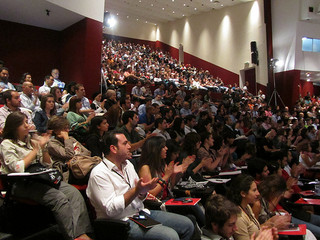
In the first four parts of this five-part series we talked about measuring event marketing, capturing the reach of your events, understanding event marketing impact, and event marketing ROI. This last post in the series is about reporting. All of your hard work is for nothing if you don’t deliver the data in a way that people will understand (not to mention, actually read).
The first and most important thing to keep in mind is your audience.
You’ll find that during most event marketing programs, there are two types of audiences:
- Those who are responsible for the day-to-day tactical execution of the program
- Those who are interested in the brand strategy and overall program’s strategic outcomes.
Each of these groups cares about very different data. They’ll tell you they want to see both tactical and strategic data, but that’s because they don’t fully understand what it is they are really looking for. People always ask for all the data when they don’t know what they want. The thinking is that they’ll just get everything and figure out what is useful later.
How to manage both types of audiences
You want to take the lead and provide them with direction and insight without having them do all the work.
First of all, when you’re the one providing direction and insight, you’re framing the discussion. The party who frames the discussion has the most control over where that discussion goes. If you’re on the agency side, it’s always going to be in your best interest to manage the discussion.
Secondly, you’re expected to know. The brand teams have a million things they’re responsible for. The marketing and, more specifically, your channel of marketing, is only a very, very small portion of all that. They outsourced and hired you because it’s what you do all the time and, therefore, you’re expected to be the expert. Experts come to the table with direction.
Reporting to Day-To-Day Managers
Your tactical folks, your day-to-day managers, the people on your weekly status calls – they all want to know if things are trending as expected. This group is all about avoiding surprises. You want to show them progress reports and trends analysis.
For example, they’ll probably care a lot about how many samples you’ve distributed to date. But you can take it further, by showing them how many samples you’ll deliver if you continue at the current pace. If you’re off the pace, you can show them why, and what you’re doing to get back on track. If you’re ahead of pace, you can let them know how you’re going to manage the inventory challenges if you run out of samples too soon.
Either way, you’re showing them that their program is being managed and will turn out as expected because it’s being well-managed. We have some great reporting techniques here if you need help.
Reporting to Program Managers
Then you’ve got your strategy folks. These are the people you sold the project to in the first place (or the ones allocating the budgets) and they’re also the people responsible for the overall brand strategy and marketing outcomes. They don’t want to be bothered by the logistics. If you’re showing them tactical data, then you’re asking them to do your job.
Don’t ask them to do your job. Show them how your job is making their job easier.
Show them impact data… data that defines how your marketing and your sampling execution strategy delivered the changes in attitude and behavior that they needed to reach their brand objectives. Show them real return-on-investment modeling that demonstrates, not only what the overall return was in real dollars, but also how and where that return was maximized and how this should affect future strategy.
If how to do this isn’t obvious, then let us know. We’re event marketing measurement consultants. We can help.
Reporting is where it all comes together. It’s where you create the permanent record of what you did and why it was worth the $450,000 or $4.5 million spent on the event marketing program. That report should be a masterpiece – both in how it looks and in what it says.
It’s quite literally the million-dollar report.
Photo Source: https://portma.com/wp-content/uploads/2014/04/recap5of5.jpg
